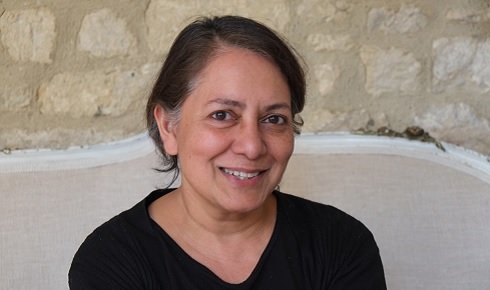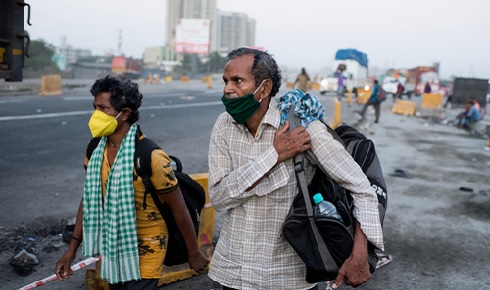"All I'm presenting is a range of possibilities"

Theoretical epidemiologist professor Sunetra Gupta talks to Tom Ireland about alternative models of how and when COVID-19 could have spread through the UK
Sunetra Gupta is professor of theoretical epidemiology at Oxford University’s Department of Zoology. Born in Calcutta, she spent her early childhood moving between Ethiopia, Zambia and England. She is also an acclaimed writer, with her fourth novel A Sin of Colour shortlisted for the Orange Prize for Fiction in 2000.
After originally studying physics, Gupta became interested in the use of maths in biology, and the evolution of human pathogens – particularly the question of why some, like flu, become extremely diverse. She was mentored by the great mathematician, theoretical ecologist and scientific adviser Lord Robert May, who sadly died this year aged 84, and she later moved into the world of theoretical epidemiology.
In March, when epidemiologists from Imperial College London presented projections that up to 250,000 people in the UK could die, it prompted the Government to take urgent and drastic action. Meanwhile a study by Gupta’s group at Oxford suggested a range of different scenarios were possible – including the possibility that the virus had arrived in the UK far earlier than reported, and over half of the UK population had already had it.
Gupta argues that without reliable prevalence data, the true picture of how widespread COVID-19 has been across the UK is still unclear. She has also warned that nation-wide lockdowns are having an unacceptable toll on poor people, and favours strict shielding for the sections of the population most susceptible to severe illness instead.
Looking back to the study by your group in March, the headlines were that over 50% of the population may have already had COVID-19. Do you still think that scenario is possible, or were those headlines missing the point of the study?
As you say, what was the point of that study? It was to say there are a number of different scenarios that could fit the available data. The Imperial study, on which the government's actions appear to be predicated, was the worst case. But in fact, the same data could also be explained by a different scenario, where the disease had come much earlier to the UK than anticipated, and the number of infections was actually higher, and the likelihood of death was lower.
The purpose of the exercise was to just say there are these different scenarios, and we need to try and discriminate between them by doing the appropriate tests that tell us how many people have already had it. Our study was just laying out the various possibilities, including the Imperial scenario – saying these are all the different scenarios that fit the data. And we don't know yet which one is right.
It’s now June, is it not yet clear which scenario is more likely?
After publishing our study, we got a neutralising antibody assay working to try and find out. But it's been very hard to get the right representative sample to answer the question of how many people have already been exposed.
We've been looking at some blood donors up in Scotland, and that's quite a nice study, but it's not representative of even the Scottish population really. Other groups have been publishing studies too, but they are actually widely divergent, so yesterday there was a report of 60% of the population in Bergamo having antibodies, and we’ve also heard of just 5% in the Spanish population. In some cases, the low numbers come from homogenising data from areas where it's quite high with areas where it's quite low.
And another set of papers now suggest that not everybody makes antibodies – I've just read a paper which suggests only 20% of individuals make antibodies when they are infected. So the jury is still out on which of those very basic scenarios we presented actually reflects what's going on.
 Studies suggesting that not all people who have had COVID-19 have detectable antibodies have added to difficulty in understanding how many people have had the virus.
Studies suggesting that not all people who have had COVID-19 have detectable antibodies have added to difficulty in understanding how many people have had the virus. My motivation for getting into this debate is precisely what you mention, that it seemed to me a terrifying prospect that lockdown might be implemented in places like India, or in Sub Saharan Africa, where asking someone to stay at home for months is not feasible. The cost is just too high.
Of course, I come from India, I've also spent a lot of time in Africa, but one doesn't need to look that far, thinking of children locked in apartments in potentially abusive situations or with no access to green space. It immediately highlights the inequalities in people's circumstances, and of course the long term consequences are likely to be profound.
What the data suggests so far, even using the blunt tools that we have at our disposal, is that there is enormous heterogeneity in exposure. So there are hotspots where it's most likely affected a lot of people already, or the numbers of people who are already unavailable for infection will keep the risk down.
What I recommend for now is to use the tools that we've got to make a risk map in the UK. You could say 'it's really ripped through this region of Glasgow, but it's not got as far as the Clyde'. Once we have that we can better plan for the winter, when I suspect it will come back. At that point, I really hope we don't have to go into lockdown again, but that we can put resources where they are needed to shield vulnerable people. And of course I think the reason why we're in such a mess in the first place is because we haven't invested enough in the NHS.
As scientists we understand that theories and models are constantly refined and rethought, but how do you think the public perception of science is affected by contrasting views from scientists – the uncertainty, the updates and course corrections?
I think the public are not given sufficient credit. Generally speaking, this issue is not that complex – we're not talking about string theory. I feel I'm able to explain the terms of this problem to people who are not experts in the field. I'm also sure the public are up to recognising how we can have a diversity of opinion and how one must balance risks.
One of the things that I found rather painful when we published the original model in March is that some academics called it 'dangerous' – they said this is a dangerous thing. And I thought that was very odd, first given the enormous costs of lockdowns. Secondly, I think the general public understand that if the government is choosing to act on the worst case scenario from several scenarios, they will still follow the advice. The public have actually been incredibly cooperative on that front.
I think the issue now is that we're starting to know a little bit more. What do we do now? I think if policy is updated in a way that again makes some sense to rational individuals then public confidence will not be eroded. But if you say we're going to go from 1.5 metres to 1.35 metres, without any kind of justification other than 'this is following the science', then I think we do stand to lose the credibility of the public.
 A sudden and strict lockdown in India caused widespread chaos and hunger for millions of people in India.
A sudden and strict lockdown in India caused widespread chaos and hunger for millions of people in India. Mathematical modelling in particular has really come to the fore during this crisis, especially in that period where the actual virology and clinical details were very sketchy. Do you think the field has stood up to the test that's been asked of it? Are there ways that this field could improve how it works or communicates during the next pandemic?
The truth is the field is somewhat polarised. There are those of us who use fairly simple models to explore the range of possibilities that the system is capable of exhibiting, and to explore the sensitivity of the outcome to different parameters – crucial parameters such as the likelihood of dying upon infection. That's one style of modelling, which is what Bob May taught me and I think it's [a] very powerful tool. Using that kind of very simple reductionist model at the moment has led to the development for us of a universal flu vaccine which we've patented and are now developing.
Because computers have become more and more sophisticated there's now another way of modelling disease which is by making large computer simulations. That too can be enormously helpful and you can do things with computer simulations that you can't with a simple set of deterministic models. But there's a danger with those models that you just throw everything into them. And then, first of all, you don't have a sense of how pattern connects to process anymore. And secondly, the way you use those models, is that you fit them to the available data. And then you find the best fit and use that to make predictions. And I think that methodology has many pitfalls.
So there is a sort of divide between those two methodologies. Having said that, at the core of what we do, whether you use complicated models or simple models, is just this very fundamental framework, what we call an SIR framework, where people are either susceptible, infected or recovered. Funnily enough, I think all the models sort of agreed on the basic skeleton SIR that represents COVID transmission. What we're disagreeing on is basically how many people are going to die from being infected.
As well as being a very busy professor, you are also an accomplished writer and novelist. What do you think about the way science is communicated in scientific papers and the way scientists speak and write?
Well, generally there's a tendency towards formulaic formats of paper, of the language. Having said that, the reason I like physics is because it's a very precise language. In some ways that formula that people now can adhere to can actually, paradoxically make you less precise than if they allowed themselves more latitude. I mean, if you read an old paper from before the 1980s, even in the 80s – there's flavour and colour in it. I think it is part of the creative process of science.
I think one of the worst problems with science now at every level is that it's consensus driven. So there's some consensus about how paper must be written, consensus about what counts as proof, or what counts as a decent hypothesis. Everything is by consensus, so it's lost a lot of its diversity.
On a practical level, how do you manage to do research and write fiction at a high level? Where do you find the time?
The truth is that ever since I had children it's been quite tricky to juggle three things. So the answer of how I manage it is ‘badly’. I think there's a huge amount of arbitrariness in what actually gets published and what doesn't. I'm not saying that what I write is rubbish that happens to have been randomly published. But I think I was very fortunate and very determined.
And as a young scientist you never felt the need to choose between these two great passions of yours?
No, and that was the culture I grew up in. My father taught history at Calcutta University but he had so many diverse interests. He was also a film critic, a theatre critic, and he sang very well. He wrote poems and novels, but he did it in a way that was rather wonderful: he'd suddenly say, ‘oh I wrote this poem yesterday’ or he would say, ‘oh by the way, I'm going to be in this play’. There was this sense that you can just do what you want to do.
You mentioned scientific consensus earlier – what has it been like for you as a scientist who has presented views that differ to the consensus during this crisis?
Personally it has been very difficult. I feel like I've been treated like a heretic by some quarters of the community. And I simply don't understand why. All I'm presenting is an alternative viewpoint or a range of possibilities that accommodate for what other people who have done.
My basic message is that we need to figure out which one of these is the truth, or close to the truth, before entering into a contract such as lockdown, which has such drastic consequences for those who are vulnerable or economically vulnerable and the underprivileged. This is not an issue we can address on that single axis of whether the epidemic is going to flare up or go away, we have to look at it in a broader context.
Sunetra Gupta is professor of theoretical epidemiology at Oxford University’s Department of Zoology. Her research focuses on the evolution of diversity in pathogens, particularly the infectious agents responsible for malaria, influenza and meningitis. Gupta uses simple mathematical models to generate hypotheses on the population structure of these pathogens, working with laboratory and field scientists to develop and test them.


